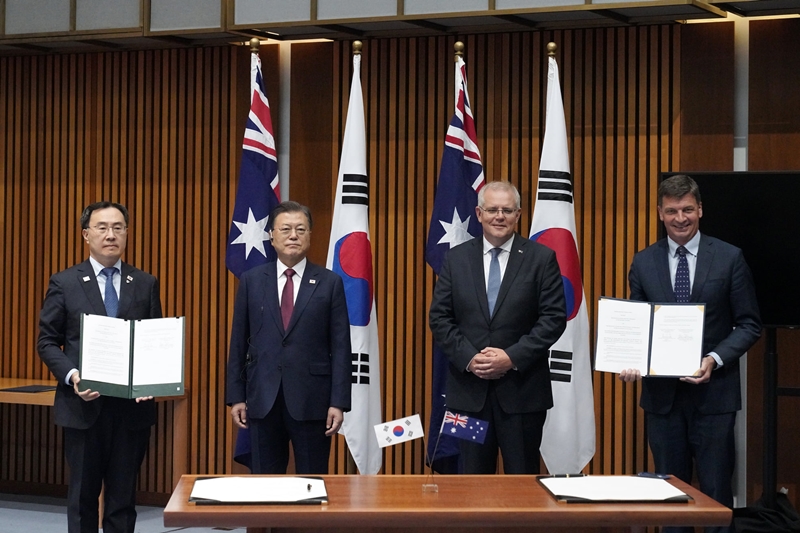President Moon Jae-in from Dec. 12-15 made a four-day state visit to Australia as the first Korean leader to visit Down Under since 2009. In Canberra, he held a summit with Australian Prime Minister Scott Morrison and agreed to upgrade bilateral ties to the level of a comprehensive strategic relationship to mark the 60th anniversary of diplomatic relations this year. The chief executive also attended a bilateral meeting on supply chains for core minerals to ensure stable establishment of supply chains for core minerals. The following are photo highlights of his trip.
By
Lee Kyoung Mi and
Yoon Hee Young
President Moon Jae-in (second from left) on the morning of Dec. 13 held a bilateral summit with Australian Prime Minister Scott Morrison (second from right) at Parliament House in Canberra, Australia. Both leaders signed a memorandum of understanding on bilateral cooperation in the defense industry, hydrogen economy and supply chains for key minerals as well as the implementation of carbon neutrality technology. They also signed a contract to supply the Australian military with 30 of Korea's K9 self-propelled guns and 15 K10 ammunition resupply vehicles, the Republic of Korea Army's main weapons system developed with domestic technology. Cheong Wa Dae called the deal a "huge achievement" attesting to global recognition of the technical and production skills of the Agency for Defense Development and Korean defense companies. (Cheong Wa Dae's official Facebook page)
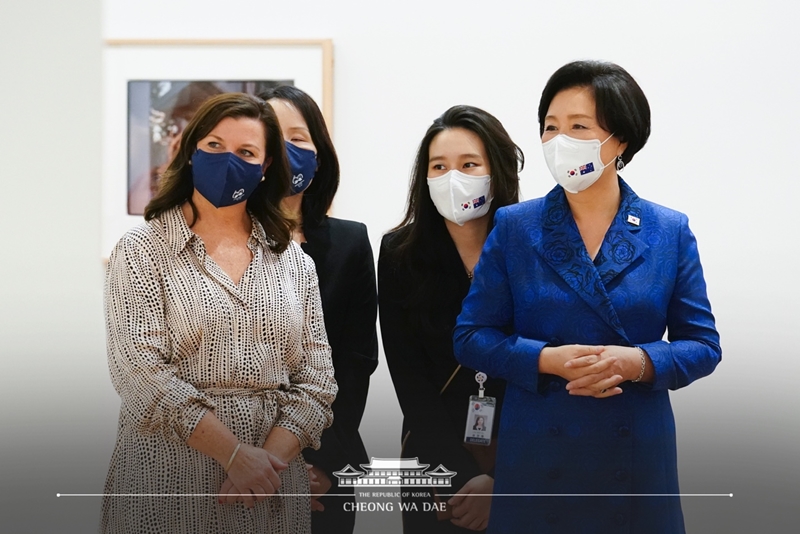
First lady Kim Jung-sook (right), who accompanied the president to Australia, and her Australian counterpart Jenny Morrison on Dec. 13 visit the National Portrait Gallery in Canberra to see the exhibition "Women Make History" (unofficial title). First lady Kim hailed seeing the portraits of the women who made Australian history while marking the 60th anniversary of bilateral ties this year. She added that she hopes for the expansion of mutual cultural exchanges in a number of sectors. (Cheong Wa Dae's official Facebook page)
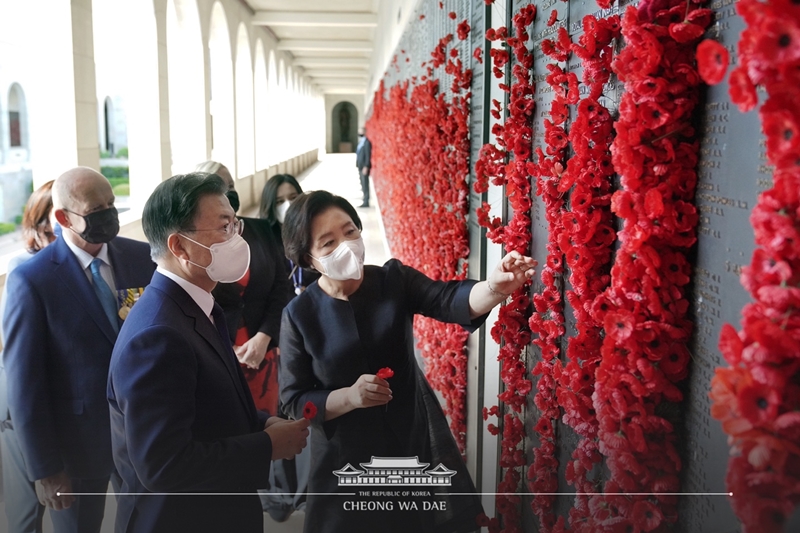
President Moon and first lady Kim on Dec. 13 visited the Australian War Memorial and Korean War Monument in Canberra to mark the 70th anniversary of the Korean War's Battle of Gapyeong, in which Australian troops participated. At the memorial, the presidential couple laid a wreath at the monuments of unknown soldiers and honored Australian veterans, and also visited the monument to pay their respects to Australian soldiers. Both countries in 2019 signed a memorandum of understanding on the excavation of the remains of Australian soldiers who went missing in action during the war and built the Australian Garden of Friendship on Jaraseom Island in Gapyeong-gun County, Gyeonggi-do Province. The presidential couple is shown here on Dec. 13 in Canberra hanging flowers on a monument listing the names of fallen soldiers. (Cheong Wa Dae's official Facebook page)
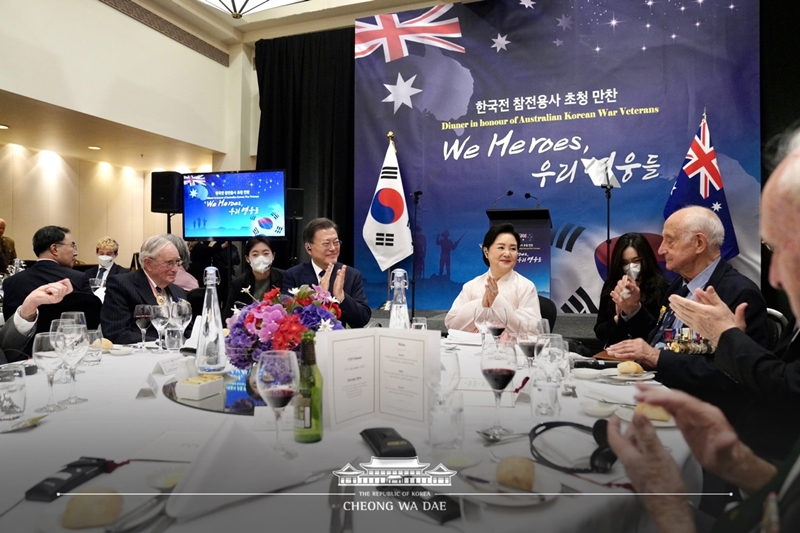
President Moon on the afternoon of Dec. 13 held a dinner in Canberra for Korean War veterans and the relatives of those killed in the war. The nearly 60 people in attendance included first lady Kim Jung-sook; Australian officials including Defence Minister Peter Dutton and Minister for Veterans' Affairs and Minister for Defence Personnel Andrew Gee; Korean War veterans from Australia; and the families of those killed in action. "The love for humanity and the dedication of the veterans who safeguarded the Republic of Korea's liberty and peace will be remembered forever in the hearts of our people. Furthermore, it will remain the foundation for the eternal friendship between Australia and Korea," the president said. "The Republic of Korea will do all it can to locate every last veteran and return them to their relatives and comrades." (Cheong Wa Dae's official Facebook page)
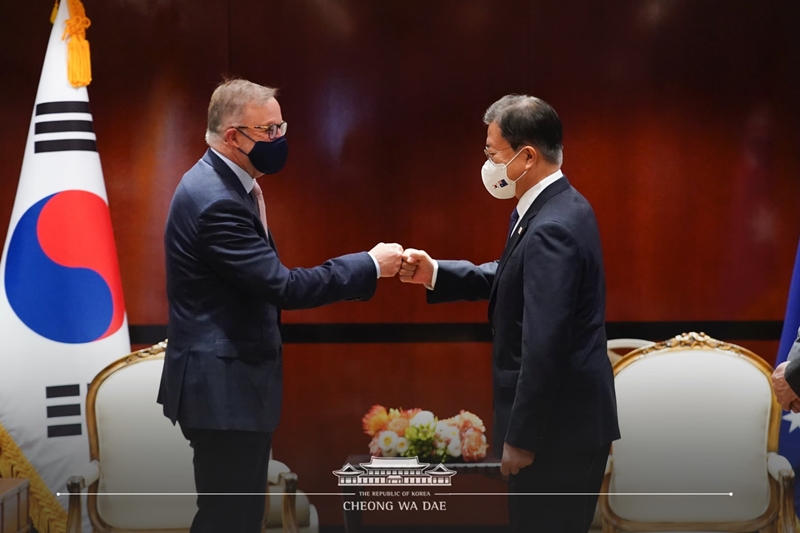
President Moon on Dec. 14 gives a fist bump to greet Anthony Albanese, leader of the main opposition Australian Labor Party in Sydney. The president said he hopes that both countries develop a future-oriented relationship with the party's bipartisan cooperation, and that the party, which has greatly contributed to cooperation with Asian countries, plays a big role in joint co-prosperity. Albanese responded by saying both sides have maintained a strong relationship under bipartisan support, adding that historically, his party has emphasized solidarity with Asian countries. For Australia's urban sustainability, he also pledged cooperation with Seoul, which is pushing sustainability in sectors including public transportation infrastructure. (Cheong Wa Dae's official Facebook page)
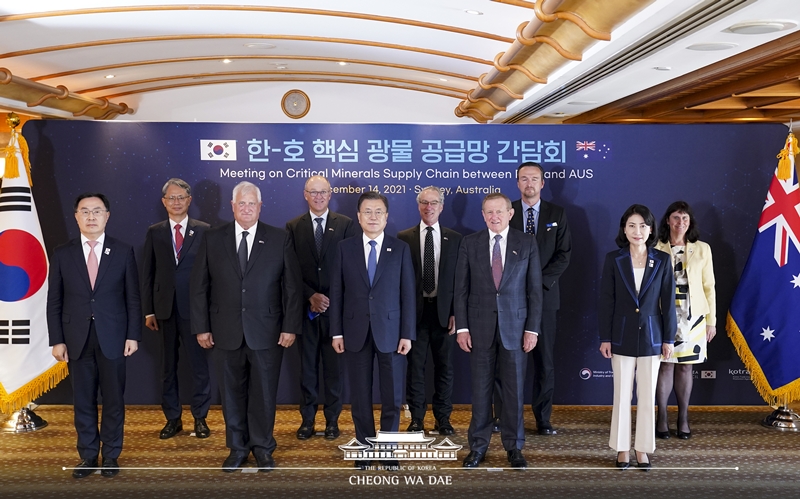
President Moon on Dec. 14 poses with Australian entrepreneurs after discussions with them on the expansion of bilateral cooperation in core minerals at the Meeting on Critical Minerals Supply Chain between Korea and Australia in Sydney. The resource-rich Australia has the world's second-largest reserves of nickel, cobalt and lithium and sixth most rare earth elements. "If our two countries firmly join hands in good faith, we will be able to make significant contributions to hastening global supply chain stability and carbon neutrality," he said. "I hope this supply chain cooperation for key minerals will be the first step for advancing more vigorously into a future of mutually beneficial prosperity." (Cheong Wa Dae's official Twitter page)
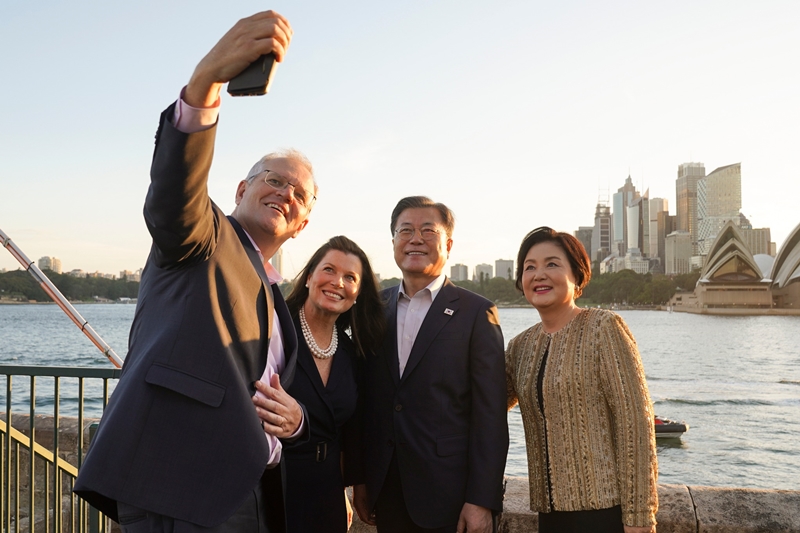
Before departing for Seoul from Sydney, President Moon on Dec. 15 delivered his impressions of his completed four-day trip to Australia on his social media, saying both countries will overcome the COVID-19 and climate crises and supply chain disruptions and lead new change. Posting a commemorative photo with the Australian prime minister and his wife in front of the Sydney Opera House, the president said his visit was made to raise bilateral cooperation in the supply chains for key minerals and rare earth elements as well as the defense industry. The two countries will share carbon neutrality technology, cooperate in the hydrogen economy and seek development in the space industry, he added. (Cheong Wa Dae's official Facebook page)
km137426@korea.kr
